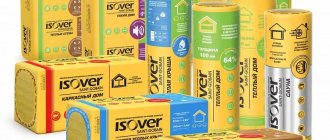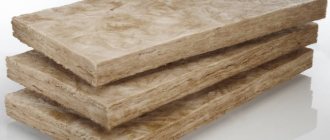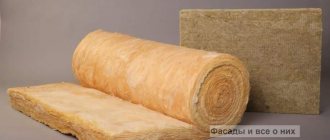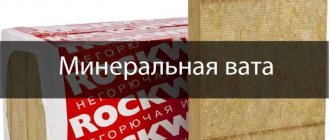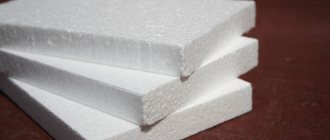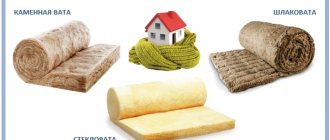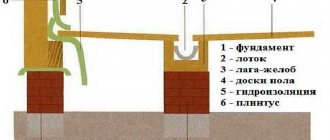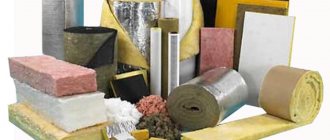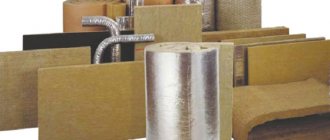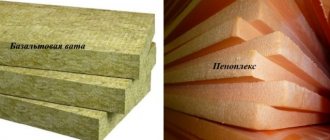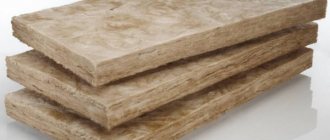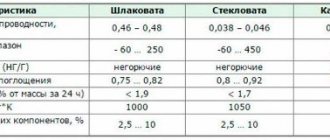Ventilated facade technology
The ventilated façade is installed using aluminum brackets, which are secured to the walls with anchors.
An aluminum profile is attached to them. After installation, a layer of insulation is installed on these elements. The panels here should fit one to the other as tightly as possible so that no gaps form. An important step is the installation of a protective film for waterproofing. The insulation of the facade with stone wool is performed on even walls. The profile must be attached to a prepared base. The plane of each aluminum element must be checked with a building level
Maintaining horizontality is especially important here - the appearance of the final finish depends on it
The system assumes the presence of a layer of air. The advantage here is the ability to ventilate the walls and quickly dry the surface. The air space will prevent moisture accumulation and promote natural ventilation of the walls. Thanks to the advantages, the service life of insulation and other materials is significantly increased.
Finishing can be done using composite panels, siding, corrugated sheets and other materials. To ensure that the finishing material adheres normally to window frames and other elements, additional aluminum fasteners are used, of which there are a huge number on sale.
Application of stone wool
The use of insulation depends on its type and type. Rigid and dense slabs, for example, are good under a floating screed. This is the name given to a floor whose leveling layer is not adhered to the base slab and is separated from it by waterproofing. Insulation is needed in the floor slab.
But, rigid stone wool slabs are especially necessary in wet façade systems. This is the name given to decorating a house using liquid mixtures rather than solid panels, for example, siding. Simply put, plaster is a wet facade. The density and characteristics of dense mineral wool blocks allow the mixture to be applied directly to them.
Among the most dense stone wool, Rockwool . Its tear strength is at least 10 kilopascals. This allows you to attach a wet facade along with a reinforcing layer to insulation boards.
The use of stone wool also affects its thickness. Maximum, for example, helps resist deflection. It occurs when there are non-standard dimensions between the spans of buildings. In this case, they take not only thick cotton wool, but also mount it horizontally. This reduces material consumption.
As you can see, when choosing insulation, you should focus not only on the main characteristics, but also on the release form. If the main thing for a frame is elasticity, then for a floor screed it’s about rigidity.
When used and selected correctly, stone wool lasts at least 50 years. The maximum time spent at the “post” is 100 years. The statement has been verified, because the first houses insulated with mineral wool are in the 3rd century.
Fastening technology
Do-it-yourself fastening of mineral wool slabs to a brick wall, lathing and under clapboard or brick must be done correctly, in a certain sequence and in compliance with all technologies. After calculating the required amount of material and determining the optimal type, you can purchase mineral wool.
Laying mineral wool on the walls outside the building can be done in the following ways:
- well system;
- wet method;
- ventilated facade.
The “well” system involves an event in which mineral wool must be laid inside the wall in the gap and between the bricks. It is better to attach insulation to a wooden surface using a ventilated facade. In this case, a frame is installed along the entire perimeter of the structure. Laying the insulation is not difficult even for an inexperienced craftsman, and fastening can be done with dowels “fungi” or glue.
Step-by-step scheme for insulating a wall using mineral wool using the wet method:
- the surface is cleaned of dust and dirt, after which it is necessary to remove depressions and irregularities from it;
- the basement cornice is attached;
- using a special composition, a layer of mineral wool is glued;
- for reliability, the insulation is fixed with dowels;
- a reinforcing layer is applied;
- the surface is properly primed and plastered;
- Can be painted in any color you like.
If for some reason the wet method is not suitable for the master, you can install the mineral wool step by step using a ventilated façade.
- The wall is impregnated with an antiseptic. If there is rot, it is worth using special compounds.
- Remove slopes and platbands.
- The surface is dried throughout the day.
- Lay the membrane layer. In the case of a perfectly flat surface, it may not be needed.
- Self-tapping screws are used to fix wooden slats, the thickness of which must correspond to the dimensions of the mineral wool. The distance between the slats should be 20 mm less than the width of the insulation.
- Cotton wool is placed in the sheathing.
- Fix the material to protect it from water and wind. Fastening can be done using a stapler.
- To create a ventilated gap, counter battens are mounted on top of the sheathing. This type of cladding should be fixed at a distance of 60 mm from the insulating layer.
Upon completion of the above work, new trim and slopes can be installed.
Common mistakes when laying material
- Lack of site preparation before work. Some workers do not first protect windows, doors, and furniture from dust and dirt, after which they become dirty and deformed.
- Ignoring surface preparation before insulation. The presence of defects, unevenness of plaster, mold, efflorescence must be eliminated before insulation begins.
- There are no starting bars that take the load from the mass of the material.
- Incorrect order of installation of slabs. The best order for laying mineral wool is considered to be a checkerboard pattern. In this case, the fixation should be tight.
- Errors in applying the adhesive composition. Such a nuisance may result in bending of the insulation or marking its outline on the finished insulated façade.
- Lack of fastening.
- No weather protection layer. This moment can lead to slow drying of the walls, and the thermal insulation itself will be ineffective.
- Lack of filling of seams at the border of the insulation. As a result, cold bridges form in the wall.
- Ignoring the use of a primer before applying decorative plaster. The result of such an oversight can be improper gluing of the plaster, surface roughness, and the presence of gray gaps.
In order to save on heating in winter, provide housing with optimal temperature conditions in the summer, prevent the formation of mold and mildew, and also soundproof the building, you can use insulation. For this purpose, many craftsmen use mineral wool, which not only has high performance qualities, but is also characterized by an affordable cost.
Mineral wool is a popular, safe material that almost anyone can use to insulate a building.
You can learn how to properly insulate the facade of a house with mineral wool from the video below.
How to attach basalt insulation to a wall for facade thermal insulation?
External systems are characterized by high mechanical and atmospheric load on the finish and the entire fastening subsystem, therefore the fixation must provide sufficient strength and reliability.
In addition, the dowels used to secure the basalt insulation must have an athermic head and a supporting mushroom cap. Let us consider in detail how to attach basalt thermal insulation to walls in plaster facade systems:
- Preparing the base . Basalt insulation slabs are glued to the walls, so their surface must be fairly flat. To do this, repair chips and potholes. Before fixing the basalt wool, priming is performed to strengthen, remove dust from the structure and improve adhesion.
- Gluing mini-slabs . Why are special adhesive compositions selected, designed to both attach basalt insulation to the walls and ensure its tight fit to the surface. Such dry mixtures ensure maximum adhesion of thermal insulation to brickwork, concrete walls and other surfaces, have frost resistance of the hardened layer, and special modifications make it possible to attach mini-slabs at sub-zero atmospheric temperatures. The glue is applied according to a special scheme, carefully working out the perimeter and applying the composition in the middle, after which the slab is pressed to the surface. The position of the miniplates is maintained using a level. After installing the first row, the second is fastened with staggered seams so that the joint of the slabs falls in the middle of the bottom line of the slabs. The rule must be followed for all subsequent stripes.
- Doweling . The basalt insulation should be attached to the wall using disc-shaped dowels after a certain time allowed for the glue to dry. Then all work is carried out both on the installation of plaster and decorative layers, and on the final painting of the facade.
To understand the intricacies of attaching mineral wool slabs to facade walls, we invite you to watch a video about installing a thermal insulation system.
How to properly insulate the facade of a house
If you do not insulate the facade of the house, the building will be constantly exposed to temperature changes, which will not have a positive effect on its frame. The presence of facade insulation also prevents other problems, such as:
- destruction of interpanel joints;
- cracks in the main building material caused by frost/heating, especially if the frame is made of foam blocks;
- change in the load-bearing properties of walls due to wear.
In addition, by insulating the house from the outside, it will be possible to improve its thermal insulation properties, which will help reduce heating costs and increase the living comfort of home owners. Before insulating the facade of a house, it is necessary to choose the right heat insulator, the use of which will be economically and practically justified.
Insulation of house facades can be ventilated or non-ventilated
Based on the regulatory documents according to which the insulation of the facades of private houses is carried out, two- and three-layer thermal insulation structures are distinguished. At the same time, the top layer of plaster is often not considered an independent unit, although it still differs in some thermal insulation qualities. If we talk about three-layer walls, then the third layer is the structural material.
According to regulatory documents indicating how to insulate a house from the outside, it is recommended to use the following types of materials depending on the type of box:
According to regulatory documents, insulation of house facades is divided into two- and three-layer heat-insulating structures
- Houses made of brick or reinforced concrete with flexible connections, just like buildings made of expanded clay, can be clad with any type of insulation.
- Wooden buildings are protected by an enclosing structure with two- and three-layer walls separated by a ventilated air gap.
- Framed walls with thin sheet sheathing require three-layer walls with a layer of insulation in the middle, which is surrounded by a ventilated or unventilated layer.
- Load-bearing walls made of cellular concrete also require ventilated and non-ventilated layers. The top is decorated with brick cladding.
When is it better to insulate the exterior of a house?
Before insulating a house, you need to know that you can begin any facade work only after the remaining construction and repair work has been completed, this includes:
- roof installation;
- performing external waterproofing of the foundation;
- installation of window and door openings;
- securing the ventilation system and other utilities.
You can begin to insulate the facade of the building only after the remaining construction and repair work has been completely completed
Many experts argue that insulation of building facades is necessary only after the house has undergone complete shrinkage and has completely dried out after construction. Otherwise, there is a high probability that the finished facade will become covered with cracks and lose its neat appearance.
Before insulating your house, you should make sure that severe heat or frost is not expected. It is best to wait until the temperature remains constant above zero during the day. The optimal time is considered to be the end of spring or the beginning of autumn, when the temperature ranges from +5 to +25 degrees. Many people recommend that before starting facade insulation, complete all internal work that is accompanied by the release of condensate, such as organizing screed and pouring the floor.
Insulating the façade of a wooden house or building made of any other material from the outside should begin after a careful inspection of the entire surface. If you have no experience in carrying out construction work, it is better to entrust this task to a specialist who will perform the required tests and check the surfaces of external walls for the adhesion of the adhesive composition used for installing the insulation. As a result of the work carried out, the load-bearing capacity of the walls will become clear, and the maximum load that will arise as a result of fastening will be calculated.
The optimal time of year to begin work on façade insulation is considered to be the end of spring or the beginning of autumn
It is important not only to carry out insulation, but also to choose modern and high-quality insulation that is most suitable for a particular building. The insulation must be not only vapor- and water-permeable, but also heat-resistant to avoid accidental fire and rapid burning
It is best if the material is environmentally friendly, and the load-bearing walls are protected from the penetration of fungi and other microorganisms that can destroy the frame, especially if it is made of natural building materials.
Thermal insulation of a brick building from the outside
External installation of insulation is considered a more practical option for a brick house.
The use of this technology allows:
- improve heat accumulation of walls;
- increase the service life of the house;
- do not reduce the usable area of the premises;
- simplify finishing work.
Installation of sheathing and laying of insulation
External installation of mineral wool on a brick wall is done in stages. First, the vertical sheathing is installed. It can be made of a metal profile; a more economical option is a wooden block 50x50 mm.
In the gaps of the frame, slabs or mats of mineral wool are laid, which are held in place due to their own elasticity.
Wind protection and finishing
A windproof membrane is attached to the top of the structure using a stapler, and the seams are taped with construction tape. An additional sheathing is installed on the membrane to provide a ventilated gap.
It will also become the basis for the façade cladding material. The best option for finishing the facade is to install siding, which is attached directly to the external frame.
Methods and technology of working with mineral wool for plaster and siding
At the moment, there are several common methods of insulating the facades of private houses using mineral wool. Among them, the most popular are:
- “Wet” facade (under the plaster layer). Initially, the mineral wool must be attached directly to the building itself. After this, plaster is applied to it, which is subsequently painted or decorated in other ways, depending on the preferences of the building owner.
- "Ventilated facade. Often used for insulation under siding. In this case, an air gap is created between the mineral wool fixed to the wall and the outer cladding layer. Its thickness must be calculated using the appropriate formula. To create a gap, an appropriate metal or wooden structure must be attached to the house. Its main purpose is to fix facing materials. This could be lining, tiles, stone, fiber cement boards, etc.
“Wet” façade
Ventilated facade
Penoplex is often used in combination with mineral wool. For example, the base is insulated with penoplex, and the walls with mineral wool.
Insulation of the facade of a private house with mineral wool can be done independently without the help of specialists. In order to do this, you need to take a responsible approach to the procedure, prepare all the tools in advance and understand the most important nuances of the work.
Preparation when working with mineral wool with your own hands
The preparatory stage involves performing certain work on the surface of the walls. Be sure to:
- remove peeling plaster;
- remove paint;
- get rid of solution build-up.
Places that have been affected by mold or mildew must be thoroughly cleaned. After this, they need to be treated with appropriate substances.
Preparatory work involves removing window casings, drainpipes and additional decorative elements of facades. After this, the walls must be primed. To do this, use a deep penetration primer.
Surface marking
In order to carry out the insulation process efficiently, it is necessary to mark the surface of the facade. To do this, you should install sags: horizontal, vertical and diagonal. First, pins or nails must be secured at different points on the facades. A nylon cord should be pulled between them as a weight gain. In this case, you should use a level. Weights allow you to identify wall unevenness and install insulation evenly in such places.
Installation of profiles for mini-slabs
Base profiles (or strips) are used as a guide that supports the first row of mineral wool on the facade. In addition, such elements help protect the insulation from rodents penetrating into it from below. For installation of profiles, driven dowels are most often used.
Fixing mineral wool boards
In order to install mineral wool on the facade, you need to use a special construction adhesive designed for such purposes.
It is prepared in accordance with the instructions. The substance should be applied to the mineral wool using a comb spatula. The glue should cover the entire surface of the sheet.
If we are talking about a ventilated façade, then before installing mineral wool on it, you need to secure special brackets in advance, where the guides will subsequently be attached.
The mineral wool itself is attached to disc-shaped dowels or mushroom dowels. Afterwards, holes are cut in the mineral wool so that it can be easily placed on the brackets. And finally, disc-shaped dowels are attached so that the “head” of the dowel holds a couple of mineral wool slabs at once.
For 1 square meter it is necessary to use up to 5-7 disc dowels. It is best to hammer them into the corners of the slabs.
Final work
The roll of mounting mesh must be fixed at the top of the wall. This can be done using pins or mortar. The material sheets must overlap each other by at least 10 centimeters.
It is allowed to perform rough plastering with a thickness of 3 to 5 millimeters. 2-3 days after this, you can begin applying the decorative layer.
Detailed description of work with basalt slabs
Before you start insulating the facade, you need to choose the most preferable method of laying stone wool. It is also important to prepare the surface and select the right tool. The work itself should be carried out in warm, dry weather.
Preparatory work and necessary tools
The list of tools depends on the chosen thermal insulation technology. Most often you will need:
- wooden slats or metal profile;
- nails, screws, dowels;
- screwdriver, drill, hammer, knife;
- waterproofing substrate and polyurethane foam;
- glue, sealant, spatulas, sanding floats;
- plaster or other decorative finishing.
To prepare the surface, you need to:
- Remove old finishing, if there was any on the facade.
- Remove all attachments that may interfere with work.
- Remove all fasteners (nails, screws, and other fittings).
- Clean the wall, pay attention to areas of mold or mildew (on wooden facades).
- Carefully seal all cracks and chips using cement mixture and sealant.
- Impregnate wooden walls with a suitable primer.
- Lay waterproofing material.
After this, you should immediately begin insulating the walls with stone wool.
Methods and technologies for laying under brick, plaster or siding
Insulation of facades with basalt wool is divided into three main technologies:
- "Wet" method. In this case, the slabs are glued to the wall, and then plaster is applied to them. This is usually done when renovating old houses. This method of insulation usually ends up with a plaster finish.
- "Ventilated facade". During the insulation process, a frame is erected, after which the slabs are placed there, while a gap is left between the insulation and the cladding for ventilation. The method is suitable for thermal insulation of any facades. This insulation method is well suited for siding.
- "Well". The slabs are placed between panels or blocks of walls under construction. Often this type of insulation is made under brick.
“Well” method
Of course, for insulation the first and second options are most often used.
After all the preparatory work has been completed, they proceed to the installation of stone wool slabs.
- A starting profile (made of slats or metal) is erected on the wall, the width of which is equal to the thickness of the slabs.
- Prepare the glue (mix the prepared solution or dilute the dry mixtures).
- It is recommended to put a reinforcement mesh in the profile, which will give the structure additional strength.
- Apply glue to the slab (along its perimeter and pointwise along the side surface). You can also use a spatula and spread the adhesive evenly over the entire side of the slab.
- The slab is laid in the profile and pressed against the facade with force.
- Remove the exposed glue and lay the second slab. When moving to the second row, it is recommended to move the slabs to the side so that their vertical boundaries do not repeat.
- When the glue hardens, the cotton wool is fixed using disc-shaped dowels to avoid possible shrinkage.
- After completing the work with the wool, it is covered with a hydro- and wind-proofing substrate, which will protect the insulation from adverse weather conditions.
Finally, the insulation is covered with plaster or other decorative finishing.
The “wet” facade technology is so named because it involves the use of liquid materials (glue and plaster). This method is quite simple and protects the facade well from various negative environmental factors. From an aesthetic point of view, the use of plaster is completely justified.
The “wet” method is suitable for both foam insulation and stone wool
If you are going to use siding for finishing, then you will have to install the insulation using the “dry” method. The ventilated façade is not particularly complicated, since to install the slabs, you again need to build a rigid frame or attach special brackets. The wool is attached to the profile with hardware, and its width must be sufficient to leave a ventilation gap between the wool and the siding.
Ventilated facade
We insulate only from the outside
Wherein:
- the internal area of the premises remains unchanged;
- the cost of heating the house will decrease: the wall material will act as a heat accumulator, which means that in winter there will be less cost for heating, and in summer - for air conditioning;
- the rooms will become quiet: the noise of car alarms and passing traffic, neighbors with karaoke and lawn mowers - all these sounds will remain outside, because fiber insulation is good sound insulation;
- the windows will stop “crying”, and the rooms will become easy to breathe, as excess moisture will escape through the walls.
- the durability of the timber structure will increase: load-bearing structures are not destroyed by moisture, fungus, low temperatures and sunlight;
- If desired, you can easily change the appearance of the facade by replacing the exterior finishing material.
True, to carry out such work it will be necessary to install scaffolding around the log house. But this is perhaps the biggest drawback of this method of insulation.
Installation of insulation for a frame structure
The technology for insulating a frame house is generally similar to the process of insulating wooden houses described above.
On the interior walls, chipboard is attached to the frame. They are joined along the beams and beams of the strapping. Then the vapor barrier is fixed and drywall or lining is installed.
Installation of mineral wool
Mineral wool slabs are laid on external wall surfaces. The number of layers depends on the region in which the house is located. The joints of the previous layer are covered with the next row of insulation. First, at the bottom of the wall, it is necessary to fix the galvanized cornice using dowels: it will help the insulation boards lie flat and protect the building from rodents and insects.
You can fix the mineral wool on the wall using a special adhesive solution. It is applied to the back side of the mat, slab or roll, which is then applied from bottom to top, easily pressing it against the wall.
You can attach the heat insulator with dowel-nails “umbrellas”. It is necessary to control that the material does not move apart when punched. Its surface is smoothed with sanding brushes. A primer mixture is applied to the mineral wool mats or slabs.
Creating an air gap and finishing
The sheathing will help retain the heat insulation layer. It will also create a ventilation gap between the windproof membrane and the outer skin. Chipboard is installed on the sheathing. Then the cladding (for example, siding or lining) is installed.
Thus, mineral wool slabs placed between the frame posts will be sewn between the chipboard slabs from the outside and inside.
Characteristics and types of mineral wool
3
- Glass wool
. The insulation layer made on its basis is particularly elastic and highly durable. When laying it, you should use personal protective equipment for the skin and eyes: special glasses, thick clothing and work gloves to avoid contact with glass microparticles on the body. - Slag
. Due to its excessive hygroscopicity, insulation with this material is not suitable for metal surfaces, but it is suitable for facades made of wooden beams. - Basalt (stone) wool
. A distinctive feature of façade insulation with this material is the ability to work with it without personal protective equipment. Compared to other types of insulators, basalt wool has the best characteristics.
Types of mineral wool
The building materials market is saturated with a variety of insulation materials, among which mineral wool occupies a special place. On the Internet you can find a huge number of photos of insulating a house using mineral wool. The raw materials for its production determine the type of cotton wool itself. It can be stone, slag or glass.
Stone wool is made from basalt, granite or porphyrite. Volcanic rock gives high results in terms of quality and durability of materials made from it.
Slag wool is produced from waste from the metallurgical industry. The material is slightly inferior to the leader because it does not cope well with sudden temperature changes in late autumn and early spring.
In addition, increased humidity from steam passing through the wall material to the outside reduces its service life. Often this type of mineral wool is used to insulate barn buildings and garages.
Glass wool is obtained by mixing glass waste, soda, limestone, dolomite and borax mineral. The material is elastic and resistant to vibrations. As a rule, glass wool is used in structures that require a high degree of fire safety.
The form of release of mineral wool is in the form of slabs of various sizes and in rolls. If the heat-insulated surface is large, then roll insulation is used to reduce the number of joints.
Mineral wool has different degrees of hardness, which are marked on the packages. Soft wool is used indoors, for example, to create heat and sound insulation of partitions. Hard and medium hardness are more suitable for walls and roofing.
Arrangement of sheathing
Those who carry out the insulation of the facade on their own, the need to install the sheathing is often linked to the fastening of mineral wool to the wall. But that's not true. The mats adhere perfectly to the wall surface with glue and dowels. So, before painting the facade, it is enough to strengthen the surface of the mats with fiberglass reinforcing mesh, and apply a layer of putty on top. The grille does not get stuck on frame walls either. Here the insulation is placed between the frame posts.
Lathing is needed when insulating walls outside with mineral wool for siding, block house, imitation timber, lining, etc.
Using the example of sheathing for siding, we will analyze step by step the technology for attaching it to the wall. To work you will need:
- wooden beam 40x40 or 50x50 mm. Dry, straight, with a smooth surface, without falling knots, dark spots and mold;
- metal hangers or bars for attaching the sheathing to the wall.
Pros and cons of using mineral wool for wall insulation
Mineral wool is presented, depending on the source raw material, in three types: glass wool, basalt wool and slag wool.
Each type has its own characteristics, advantages and disadvantages. It is because of them that slag wool is not used for insulating facades: with high hygroscopicity, it quickly becomes damp. At the same time, it not only loses its thermal insulation properties, but also corrodes all materials with which it comes into contact - hydrochloric acid is produced during contact with water.
Glass and basalt wool have both common strengths and weaknesses, as well as individual ones.
General benefits include:
- excellent thermal insulation properties - the thermal conductivity coefficient ranges from 0.035 to 0.052 W/(m K);
- versatility. In addition to the facade, basalt and glass wool is used to insulate the floor, roof, ceiling in the attic, as well as walls from the inside of the room. Mineral wool insulation perfectly copes with its functions in houses made of wood, brick, concrete, aerated concrete, foam block, gas silicate blocks and other materials;
- resistance to high temperatures - glass wool can withstand heating up to 300oC, basalt fiber up to 1000oC;
- perfectly resist mold and mildew - glass and basalt fibers do not provide a basis for the development of microorganisms;
- light weight, which does not create loads on the insulated elements of the building;
- ease of delivery from the retail outlet to the place of insulation;
- simple insulation technology - all thermal insulation work can be done with your own hands;
- environmentally friendly - the material does not cause allergic reactions, during the heating process it practically does not emit harmful substances;
- fire resistance - flammability class NG.
Insulating the outside walls of a house with natural wool also has disadvantages, which include:
- connecting seams through which heat loss begins during operation (mats shrink, losing their shape). However, when using modern technologies for attaching thermal insulation boards to the wall, heat loss can be minimized;
- dust - formed during the installation process requires mandatory protection of the body and respiratory tract.
At the same time, basalt wool has several advantages that fiberglass insulation does not have. This:
- durability - the service life of the material is at least 50 years;
- low hygroscopicity. Experiments show that fibers immersed in water absorb only 0.095% of moisture per day;
- good noise absorption, up to 75 dB, of sound waves traveling through the air. Basalt insulation is powerless against impact and structural noise (spread by house structures);
- resistance against mice and rats - they do not eat cotton wool, do not make passages and nests;
- inertness to chemically active substances used in everyday life;
- high level of elasticity - the mats retain their dimensions throughout their entire service life;
- sufficiently high tensile strength, which makes it possible to insulate the facade using the “wet method” (apply a layer of decorative plaster directly to the insulation).
The disadvantages include the high price.
Glass wool also has individual advantages and weaknesses. The advantages include low cost.
The list of shortcomings is wider:
- high hygroscopicity, which requires insulation to be insulated from moisture. Otherwise, destructive processes begin in the wet fibers, as a result of which the glass wool cakes and settles, forming uninsulated areas;
- short service life - about 10-15 years;
- low resistance to the class of chemicals represented by alkalis - fiberglass is destroyed under their influence;
- attractive to mice and rats - serves as a habitat for them.
Detailed information about mineral wool can be found in the material “Minewool for insulation”.
Specifications
Stone wool has a number of advantages compared to other types of insulation, which determine the scope of its use and the variety of places of application.
Description, types and features of production
Stone wool is produced, as already written above, from melts of various rocks. The most common type of stone wool is a material made from basalt; such insulation is also called “basalt wool”.
Stone wool is made in special furnaces in which natural rocks of mountainous, volcanic origin or basalt are melted at high temperatures.
The rock in a liquid state is drawn into fibers, to which binding components are added, after which the threads (fibers) are treated with special solutions that improve the technical characteristics of the resulting product.
After this, the threads are once again thermally treated, resulting in their polycondensation and the formation of insulation in the given geometric dimensions.
When forming stone wool slabs, resins based on phenol and formaldehyde are used.
Types of stone wool
Depending on the rigidity of the resulting insulation, basalt wool is classified as:
- Soft.
- Medium hardness.
- Tough.
The soft type of stone wool is made from fibers of the smallest thickness, which, when forming a slab, create a large number of air cavities that determine the product’s ability to retain heat.
This type of insulation is prone to destruction under the influence of external mechanical loads, so it is used in the construction of roofs, ceilings, floors and other building structures, which are covered with other materials during finishing.
Soft stone wool in rolls is used to insulate roofs and ceilings
The material is of medium hardness, made from thicker and correspondingly stiffer fibers, which allows it to be used for insulating facades, engineering structures (ventilation and cable ducts, heating mains), as well as other types of work (sound and fire safety) at similar facilities.
A hard type of stone wool, used in places where there are significant mechanical loads. Products of this type are laid under concrete screed and plaster directly on their surface with the installation of a reinforcing layer.
Stone wool is produced in the form of slabs (medium hardness and hard type) and rolls (soft type), as well as special cylinders used for thermal insulation of pipelines.
Rigid stone wool slabs are used to insulate facades.
Main technical characteristics
The characteristics that determine the physical properties of stone wool are:
- Thermal conductivity. The ability to transmit heat through its surface. The thermal conductivity coefficient for this type of insulation is from 0.032 to 0.048 W/(m*K), depending on the type and raw materials used.
- Hydrophobicity. Ability to absorb moisture. For this material, this figure is less than 2 percent of the volume of the product, which indicates that stone wool practically does not absorb water and can be used in rooms with a damp environment (bathrooms and showers, kitchens and bath rooms, as well as basements and exterior finishing).
- Vapor permeability. The ability to pass substances in a vapor state. The vapor permeability coefficient for stone wool is 0.3 mg/(m*h*Pa). When water vapor penetrates the surface of the insulation, condensation does not form and moisture is not absorbed into the structure of the material.
- Fire resistance. Ability to resist flame spread. Stone wool is a non-flammable material that does not support combustion. The material is able to withstand high temperatures, above 1000 * C, without melting and preventing the spread of fire.
- Soundproofing. Stone wool is a good sound insulator that can dampen sound waves.
- Strength. Due to the fact that the insulation is made from a large number of threads, even soft-type products have a certain margin of strength, while medium-hard and hard ones can withstand significant external mechanical loads.
- Resistance to chemically active substances and biological organisms. This material is chemically passive. It does not enter into chemical reactions with materials (wood, metal, plastic and others) and is not susceptible to the formation of microorganisms and mold, and is also not affected by rodents.
- Environmental Safety. Although in the production of stone wool resins based on phenol and formaldehyde are used, but since their quantity is insignificant, then this material is considered environmentally friendly, moreover, during the production process, these substances are neutralized.
- Geometric dimensions. The thickness of the sheets (roll) is a multiple of 50.0 mm, while this value is the minimum possible, and the maximum size produced is 200.0 mm. When selling stone wool in rolls, its length can be 10.0 m (depending on thickness) and width 1.2 meters. When sold in slabs, the size is 1000x1200 mm.
How to choose?
If you decide to insulate your home, you need to know a few rules to choose the right material.
To do this, it is important to take into account the characteristics of the structure where the work will be carried out: is it residential or commercial, what material was used during construction
Experts recommend calculating in advance the density of mineral wool that will suit the task. It is worth noting that often errors occur not due to poor quality of the material, which happens quite rarely, but precisely due to improper use. Therefore, before purchasing, it is better to study all the technical characteristics and features of using a particular category of mineral wool.
Slabs with increased density are in great demand - they have minimal moisture absorption rates, so this option is best suited for finishing facades
To insulate the room, you can pay attention to mats - this is a rolled material, the design of which is quite convenient
It is important to consider the material from which the walls are made: if they are wooden, the density should not be high, because the surface must breathe, otherwise it will become moldy. There is an unspoken rule that for thin walls it is necessary to take a thick layer of thermal insulation
Advantages and disadvantages of mineral wool
Mineral wool has a wide range of applications in construction work for insulation. This is due to its high performance characteristics:
- Durability.
- Low thermal conductivity.
- Vapor permeability.
- High level of sound insulation.
- Easy to install.
- Non-flammability.
Low thermal conductivity, as one of the main indicators of insulation, prevents heat loss in winter and prevents the building from heating up in summer.
Vapor permeability allows steam to pass through the fibers of the material, but not to accumulate in them, but to be released outside. This prevents the occurrence of mold and mildew.
Good sound insulation is also provided. Depending on the type of material, air or impact sound insulation is performed. This indicator is indicated on the packaging of the insulation. The non-combustibility of the material confirms that mineral wool can withstand temperatures up to 1000 degrees. Therefore, the material does not burn.
When working with mineral wool, you must follow safety precautions, because it has its drawbacks.
It protects the respiratory tract from such dust getting into it.
The material also releases formaldehyde resin, which is also harmful to health. To avoid this, it is enough to work with the product at room temperature - this substance will not be released under such conditions.
Having studied the characteristics of mineral wool, you should familiarize yourself with the features of its use and the cases in which it is recommended to use this material.
Stone wool price
Typically, the price of stone wool is per package. It usually contains several sheets. So, for 4 pieces measuring 100 by 50 and 10 centimeters they ask from 300 to 900 rubles, depending on the density, composition of the insulation and its name. This refers to the name of the manufacturer and its fame.
Four mineral slabs measuring 120 by 60 by 5 centimeters cost from 500 rubles. As you can see, rolled products are more profitable. However, the most attractive options are offered when recycling goods.
When selling off leftovers, some warehouses sell stone insulation at 3-4 times cheaper than the market price. There are even special utility services. One of them currently offers stone insulation at 30-40 rubles per kilogram.
Insulation materials. How to choose a “fur coat” for your home?
All insulation materials are divided into two categories:
- Organic.
- Inorganic.
The first group is more numerous. It includes chemical industry products such as polystyrene foam and penoplex, as well as natural ecowool insulation.
When answering the question of how to properly insulate a facade, you must first consider the physical properties of the materials offered on the market.
Foam plastic and penoplex
Foamed polymers, which include foam, by definition cannot be called durable. The aging process, characteristic of any plastic, goes much faster here. The reason for this is the huge contact area of polystyrene with the air contained in its structure. Therefore, manufacturers’ statements about a 50-year and even more so a 100-year service life cannot be considered serious and objective. This type of insulation will last you no more than 20 years, after which it will have to be replaced.
Penoplex is the same polystyrene foam, but produced by extrusion (at elevated temperature and pressure). It is more durable and stronger than ordinary polystyrene foam, but still does not reach the 50 years of operation promised by advertising.
If you can somehow come to terms with the relatively short service life of polystyrene foam, then you can argue with statements about its “super environmental friendliness”. As this insulation ages, it decomposes, releasing toxic styrene. Although its concentration is low, and the process of diffusion into living spaces through walls is difficult, nevertheless, this fact casts doubt on the cheerful statements of the manufacturers.
The second incorrect statement regarding polystyrene foam is its excellent soundproofing qualities. This material is quite rigid and at the same time very light. This combination of properties is not typical for effective sound insulators. Therefore, insulating the facade with foam plastic does not provide a noise-reducing effect.
Insulation of the facade with foam plastic - saves heat, does not absorb sound
The undoubted positive qualities of foam plastic and penoplex are ease of installation and ease of finishing. Due to the rigid structure of the insulation, plaster can be applied to it or light ceramic tiles can be glued onto it.
Speaking about facade insulation with polystyrene foam, you should pay attention to thermal panels with clinker tiles. This composite material does not require finishing
It is obtained by foaming polystyrene in the same form as the facing tile. This ensures strong adhesion of the insulation to the exterior finish.
More expensive thermal panels are produced using polyurethane foam instead of polystyrene foam. Installation of composite insulating cladding is carried out using a special glue, joining the panels with serrated protrusions.
Ecowool
The direct opposite of polystyrene foam and other foamed polymers. It is made from natural cellulose, so it deserves the name of environmentally friendly insulation. Ecowool contains minerals - borax and boric acid. They are safe for health and are designed to protect cellulose from rotting, fire and rodents.
Ecowool has high sound-absorbing characteristics. Its loose structure dampens acoustic vibrations well. The breathability of this insulation corresponds to that of natural wood.
Take this fact into account when deciding how best to insulate the facade
The disadvantage of ecowool is the impossibility of applying it to the facade using a dry method. Therefore, most often wet technology is used for insulation. It consists of spraying damp ecowool onto the walls. When dry, it forms a dense and warm shell that adheres well to a vertical surface. The finishing finish for ecowool is plaster, magnesite board or blockhouse.
Wet method of insulation with ecowool
The dry insulation method is only suitable for frame buildings. They have cavities between the outer and inner lining, into which ecowool is blown.
Mineral wool and glass wool
The second group of materials for insulation is represented by basalt mineral wool and glass wool. Glass wool insulation is rarely used today. During installation, it releases tiny particles of glass that enter the respiratory system and cause harm to the body. Mineral wool is safer in this regard.
It should be noted that loose roll insulation made of mineral wool is not suitable for the facade. Therefore, in practice, semi-rigid or rigid slabs (density from 90 to 200 kg/m3) are used. They are fixed to the walls using construction adhesive and disc dowels.
Facade cladding with rigid mineral wool slab
When deciding whether polystyrene foam or mineral wool is better for insulating a house, many owners prefer the more durable basalt material.
Types of stone wool
If the first stone wool was made from volcanic slag, then other rocks were used. Contemporaries know insulation materials made from limestone, quartz sand, dolomite, diabase, and basalt. The characteristics of the raw material also determine the properties of the wool. Let's start listing the characteristics.
- Slag wool. Modern samples, instead of being of volcanic origin, are of metallurgical origin. The raw material for insulation is blast furnace slag. Its basis is sulfur oxides of metals. In addition to them, slags include silica, alumina and lime. The latter is calcium oxide.
Silica is an oxide of silicon, and alumina is an oxide of aluminum. Their mixture forms fibers 4-12 microns thick and 1.5 centimeters long. They suffer from pollution and high moisture holding capacity. Therefore, water pipes and building facades are not insulated with slag wool. Inside residential buildings, slag wool is acceptable as long as it is securely sealed.
However, more often the insulation is used in dry temporary and utility rooms. There slag wool can withstand up to 50 degrees below zero. If there is a fire, the insulation will melt already at 300 Celsius.
- Stone basalt wool . Basalt is a volcanic, dense and heavy rock. The insulation from it also turns out to be heavy. This leads to caking of the material under its own weight. However, fixed to the walls and roof, basalt fiber retains its shape. The insulation threads are as short as in slag wool.
This leads to fibers breaking and sticking to the body and clothing. Therefore, installers do not like basalt insulation. Even with full protective equipment, cotton wool manages to “get through” to the workers.
- Sand wool is otherwise called glass wool. The grains of sand are quartz, consisting of silicon oxide. Soda, borax, and limestone are added. It turns out glass. The material is artificial, but consisting of natural, mineral components. The resistance of their alloy to fire is less than that of materials made from solid stones.
Glass wool begins to change its structure already at 250 degrees. The same basalt withstands 1,000 degrees Celsius, and tolerates minus temperatures up to 190 degrees. Glass wool is also inferior in moisture resistance. It is similar to slag material. Basalt almost does not absorb water.
- Wool from diabase and dolomite is called mineral wool. This insulation does not prick and does not absorb moisture. At the same time, the material allows water vapor to pass through, just like all stone wools. The melting point of mineral insulation is average, about 600 degrees. Cotton wool can withstand sub-zero temperatures down to -45.
There is also a classification of stone wool by brand. Their main difference is the density of the material. Hence the difference in properties, which is no longer due to composition, but to structure.
- P-75. A brand with a minimum density per cubic meter. How many kilograms it accounts for can be seen from the name of the brand. The products underneath are used to insulate horizontal surfaces with low loads, for example, attics. Under heavy load, wool shrinks, losing its heat-saving characteristics.
- P-125. This cotton wool is suitable for insulating interior partitions, walls, and ceilings. At the same time, there is still enough air in the insulation to block noise and retain heat, so to speak, at the highest level.
- P-175. This is already a material of increased density, purchased for insulation of reinforced concrete walls and ceilings. Externally, the product looks not so much like cotton wool, but like a slab of wood chips.
- P-200. The most dense and hard cotton wool. For every cubic meter there are 200 kilograms of weight. The brand's products are also used for reinforced concrete structures. The density of stone wool is such that noise insulation is reduced, and the material retains heat worse than its “colleagues” in the workshop.
If we take the average thermal conductivity indicators, they are minimal for slag wool, amounting to 0.460-0.480 units. In second place is basalt. Its thermal conductivity is 0.350-0.440. The mineral wool index is reduced to 0.077, and the glass insulation index to 0.035.
Stone wool can also be classified according to its release form. Often the insulation comes in the form of twisted tracks, that is, rolls. Slabs are produced less frequently. They come in different sizes and thicknesses. Stone wool 50 mm is the most popular option. For extreme insulation, slabs 10 centimeters wide are used.
Whatever the size of stone wool slabs, they are larger than rolls. There are difficulties with transportation. Therefore, the tiled form of release is inferior in demand. Even less often, but due to narrow specialization, they purchase cylindrical products.
The use of stone wool of this type is associated with the insulation of chimneys and pipelines. In order for the cotton wool to “sit” on them, its cylinders have seams or locking joints.
